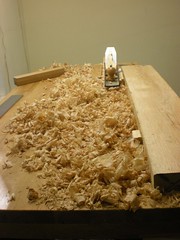Tuesday, November 17, 2009
The Bottleneck
Why did the Neanderthals disappear? They lived for 400 thousand years.
Why did Homo Sapiens survive and all others disappeared?
What is the differentiation factor?
Saw this one on TV last week
Becoming Human Last Human Standing
Though there is an embedded message.
We are at another evolutionary bottleneck. Another resource crunch. The bottle-neck of Peak Oil. Those of us who can survive and adapt to a much lower energy lifestyle will come out of this bottleneck. Rest will disappear in the endless sand of time and become the Neanderthal fossils. We need to redefine progress and growth. Infinite growth on a planet is mathematically impossible. Rest of the world wants to follow the so called 'developed' nations. This is not a path to prosperity but a path to the proverbial yeast killing itself in its own alcoholic excrement.
Growth is embedded in human evolutionary physiology. It is impossible for politicians, corporate leaders and rest of the people in power to even think of a path other than growth. Anyone who wants to come out of the bottleneck ahead of us must think against the concepts of growth embedded in our DNA and move to much much lower energy lifestyle.
Thursday, November 12, 2009
Toddler socks

I made this pair of socks for my toddler son last year.
Instructions
These are made in sport weight yarn, with a ribbed leg. You can do them in one colour, or in a combination of colours. I made a pair in orange, with black stripes at the top of the leg and black for the heel and toe. (they were for the baby of a teacher I work with, and these are the school colours!)
**Special Abbreviation: ssk - this is an alternative to the old psso decrease. To ssk, you slip the next two stitches knitwise, then insert the tip of the left hand needle into the front of these two stitches, then knit them together. If you prefer, you could always use the psso decrease instead. (Slip 1, knit one, pass slipped stitch over), but I find the ssk is quicker and neater.
Materials:
One set of 3.25 mm double-pointed needles.
Sport or DK weight yarn.
Optional: contrast for stripes, heel and toes.
Cast on 32 stitches, distributed evenly on three needles:
1st needle: 10 stitches
2nd needle: 12 stitches
3rd needle: 10 stitches
Rib in k1, p1 ribbing for 4 inches.
Heel:
k1, p1 for 8 stitches off of the first needle. Turn, p8, then p8 from third needle. You now have 16 stitches on one needle for the heel flap. Turn.
Work another 12 rows in stockinette stitch.
Turning the heel:
Row 1: k8, place marker, k2, ssk, k1, turn
Row 2: sl 1, purl to 2 stitches past the marker, p2tog, p1, turn
Row 3: sl 1, knit to 3 stitches past the marker, k2tog, k1, turn
Row 4: sl 1, purl to 3 stitches past the marker, p2tog, p1, turn
Row 5: sl 1, knit to 4 stitches past the marker, k2tog, turn
Row 6: purl to 4 stitches past the marker, p2tog, turn
Row 7: knit
Pick up 8 stitches along the first side of the heel flap. Using the second needle, knit across the 16 instep stitches. Using a third needle, pick up 8 stitches on the other side of the heelflap, and knit 5 stitches from the first needle.
Shaping the instep:
Next round: knit
Decrease round: 1st needle - knit to last three stitches, k2tog, k1.
2nd needle - knit across.
3rd needle - k1, ssk, knit to end.
Repeat these two rounds until there are 32 stitches remaining.
Knit 15 rounds in stockinette stitch.
Shaping the toe:
Next round: knit
Decrease round: 1st needle - knit to last three stitches, k2tog, k1.
2nd needle - knit 1, ssk, knit to last three stitches, k2tog, k1.
3rd needle - k1, ssk, knit to end.
These instructions are from geocities.com but the link is not working.
Useful youtube vidoes:
Sunday, November 1, 2009
1840s Carolina Village
This place is close to Hickory NC. It was raining very hard so the drive up there was not too great. There was no rain at Hart Square so we were able to enjoy rest of the day. Life back then was simple with no plastic pumpkins. There was no TV, no malls and people had real jobs.
I took as many pictures I could from different types of professions people had back then like coopering, shoe making to wheel wrights.
We picked up a pound of $2 corm meal from the water driven grain mill. The corn bread made from this corn meal was delicious :)
Pictures cannot do justice to the great atmosphere that me and my family enjoyed that day. Please enjoy this sideshow of over 200 pictures. The originals of each picture is 16X of the one shared on web. If anyone is interested in any specific original then please leave a comment on my blog and I will get back to you.
Wood Shaving's from board Jointing
#7 Jointer plane. Its a beautiful product from Lie Neilsen.
Works right out of the box without any need for tuning.
This picture below tell the story of shavings from this
white oak board. I could have had this board jointed at
the lumber yard for $0.35/bf but I would have denied myself
the joy of shaving and some arm exercise.

